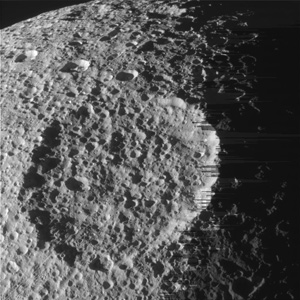Oh. My.
Another lovely, stunning Cassini image: A thin crescent Enceladus rising over the sunlit cloud tops of Saturn:
What a sight! As the spacecraft rounded into the dark side of Saturn, it turned back toward the planet (and the far more distant Sun). The top of Saturn’s atmosphere is still lit as seen from Cassini’s vantage point, but also lit was the moon Enceladus. The moon was between Saturn and Cassini, and so the geometry dictates it too was showing almost entirely its dark side to the spacecraft. The result is the thin crescent of the moon just over the (only partially seen) thinly lit crescent of its parent planet.
 This raw image (meaning it has not been processed to remove camera defects and other artifacts) is one of several available on the CICLOPS site. There are other shots of Enceladus which show its famous string of geysers, and incredible close-ups of craters on the moon Tethys – like the one shown here (click to embiggen).
This raw image (meaning it has not been processed to remove camera defects and other artifacts) is one of several available on the CICLOPS site. There are other shots of Enceladus which show its famous string of geysers, and incredible close-ups of craters on the moon Tethys – like the one shown here (click to embiggen).
The average density of Tethys is actually less than that of water, meaning it is mostly ice. Clearly, Tethys has had a rough past; the surface is saturated with craters (the weird lines on the right hand side are one of those camera artifacts I mentioned, and aren’t real). The moon is nearly 1100 km (660 miles) across, so clearly Penelope, the large crater you can see there, is enormous… and old, at least old enough to have suffered multiple peppering impacts in the time since it was created.
The other images on the CICLOPS site are wonderful, and you should look. Also, Emily Lakdawalla took a few of them and made animations which are particularly amazing. Zoom in on Enceladus, or watch it rise in front of Saturn!